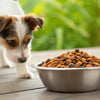How Much Dry Food Per Day for Dog: A Comprehensive Guide for Pet Owners
- Houndsy
Table of Contents
- Introduction
- Understanding Your Dog's Nutritional Needs
- Feeding Guidelines: How Much Dry Food Should You Serve?
- The Importance of Quality Dog Food
- Practical Feeding Tips
- The Consequences of Overfeeding and Underfeeding
- Conclusion
Introduction
Did you know that approximately 59% of dogs in the United States are classified as overweight or obese? This startling statistic highlights the critical role that nutrition plays in our furry friends' health and well-being. As pet owners, we strive to provide the best for our dogs, and one fundamental aspect of their care is ensuring they receive the right amount of food each day. However, determining how much dry food per day for dog can be a complex task, influenced by various factors including age, size, activity level, and overall health.
In this blog post, we will explore the essential considerations for feeding your dog the appropriate amount of dry food, focusing on how these factors can guide your decisions. By the end of this article, you will have a clearer understanding of how to tailor your dog's diet to meet their unique needs, ultimately enhancing their quality of life. From examining feeding guidelines to understanding the implications of overfeeding and underfeeding, we aim to empower you in your journey as a responsible pet owner.
Let’s dive deeper into the world of dog nutrition, explore practical feeding strategies, and discover how the Houndsy Kibble Dispenser can simplify the feeding process, making it not only convenient but also a beautiful addition to your home.
Understanding Your Dog's Nutritional Needs
Age Matters
Just like humans, dogs have different nutritional requirements at various life stages. Puppies, adults, and senior dogs all need specific types and amounts of nutrients.
- Puppies: Growing dogs require a diet rich in calories, protein, and certain vitamins to support their rapid development. They typically need to eat more frequently, often three to four times a day, to meet their energy needs.
- Adult Dogs: Once dogs reach maturity (around one year old), their caloric needs stabilize. Depending on their size and activity level, most adult dogs do well with two meals a day.
- Senior Dogs: As dogs age, their metabolism may slow down, and their activity level often decreases. Senior dogs may require fewer calories to maintain a healthy weight, and special diets may help address age-related health issues.
Size and Breed Considerations
The size and breed of your dog significantly affect their caloric requirements. Larger breeds generally need more food than smaller breeds. For example:
- Small Breeds (up to 20 lbs): Typically require about 1/2 to 1 1/2 cups of food per day.
- Medium Breeds (20-50 lbs): Generally need about 1 1/2 to 3 cups per day.
- Large Breeds (over 50 lbs): Often require 3 to 5 cups or more, depending on their weight and activity level.
Understanding your dog's breed-specific needs can help you determine the right quantity of food to provide.
Activity Level
A dog's activity level is a crucial factor when it comes to determining how much food they need. More active dogs burn more calories and therefore require more food. Conversely, dogs that are less active or spend most of their time lounging around may need less food to avoid weight gain. Assess your dog's daily routine:
- High Energy Dogs: Breeds that are naturally active, such as Border Collies or Retrievers, may require additional calories to fuel their energy.
- Low Energy Dogs: Breeds like Bulldogs or Basset Hounds tend to be less active and should be monitored closely to prevent overfeeding.
Health Status
A dog's health status is another vital consideration. Dogs with certain medical conditions, such as diabetes or obesity, may require special diets or portion sizes. It's essential to consult with your veterinarian if your dog has any health concerns that might affect their dietary needs.
Feeding Guidelines: How Much Dry Food Should You Serve?
Most commercial dog foods provide feeding guidelines on their packaging. These guidelines can help you determine the right amount of dry food based on your dog's weight and activity level. Here’s a general guideline to follow:
- Small Dogs (up to 20 lbs): 1/2 to 1 1/2 cups per day.
- Medium Dogs (20-50 lbs): 1 1/2 to 3 cups per day.
- Large Dogs (50-100 lbs): 3 to 5 cups per day.
- Giant Breeds (over 100 lbs): 5 cups or more, depending on weight.
These amounts should be divided into two meals per day for adults and three to four meals for puppies.
Adjusting Portions Based on Body Condition Score
A Body Condition Score (BCS) is a useful tool for evaluating whether your dog is at a healthy weight. The BCS ranges from 1 to 9, with 4 to 5 being ideal. If your dog falls outside this range, you may need to adjust their food intake accordingly:
- Underweight Dogs: Increase food portions by 10-20% to help your dog gain weight gradually.
- Overweight Dogs: Reduce food portions by 10-20% to promote healthy weight loss.
Regular vet check-ups can help you monitor your dog's weight and adjust their diet as necessary.
The Importance of Quality Dog Food
When determining how much dry food to feed your dog, the quality of the food you choose is just as important as the quantity. High-quality dog foods are typically more nutrient-dense, meaning your dog will require smaller portions to get the same nutritional benefit compared to lower-quality brands.
Ingredients Matter
Look for dog foods that list high-quality protein sources as the primary ingredients. Avoid foods with fillers such as corn and soy, and consider options that contain whole meats, vegetables, and fruits. The nutritional content should be balanced, providing the necessary vitamins and minerals for optimal health.
Special Dietary Needs
If your dog has specific dietary needs (e.g., grain-free, hypoallergenic), choose a food formulated to meet those needs. Consult your veterinarian if you have concerns about your dog's diet or if you're considering a dietary change.
Practical Feeding Tips
Create a Consistent Feeding Schedule
Establishing a consistent feeding schedule can help regulate your dog's appetite and digestion. Feeding your dog at the same times each day can also make it easier for you to monitor their intake and adjust portions as needed.
Use the Houndsy Kibble Dispenser
To simplify the feeding process, we recommend using the Houndsy Kibble Dispenser. This innovative product allows you to easily control portions and reduces the mess often associated with feeding time. With its mid-century modern design, it not only enhances the feeding experience but also complements your home decor beautifully.
Monitor Your Dog’s Weight
Regularly monitor your dog's weight and adjust their food portions as necessary. Use a pet scale or track their weight during veterinary visits. If you notice any significant changes, consult your veterinarian to determine if adjustments are needed.
Provide Fresh Water
Always ensure your dog has access to fresh water, especially if they are eating dry food. Hydration is crucial for their overall health and well-being.
The Consequences of Overfeeding and Underfeeding
Feeding your dog too much or too little can lead to serious health issues.
Overfeeding
Feeding your dog excessive amounts of food can lead to obesity, which is linked to various health problems, including:
- Joint issues
- Heart disease
- Diabetes
- Reduced quality of life
- Shortened lifespan
Underfeeding
Conversely, underfeeding your dog can result in malnutrition, leading to deficiencies in essential nutrients. Symptoms of underfeeding may include:
- Low energy levels
- Poor coat condition
- Weakened immune system
- Increased susceptibility to illness
The Role of a Veterinarian
Regular consultations with your veterinarian can help ensure you are feeding your dog the right amount of food. They can provide personalized recommendations based on your dog's unique needs and health status.
Conclusion
Feeding your dog the right amount of dry food daily is essential for their health and longevity. By considering factors such as age, size, activity level, and health status, you can make informed decisions about their diet. Remember to monitor your dog's weight and adjust their portions as necessary to maintain a healthy body condition.
As you embark on this journey of responsible pet ownership, the Houndsy Kibble Dispenser can be an invaluable tool in your feeding routine, simplifying the process while ensuring your dog enjoys consistent, perfectly portioned meals.
If you have any questions about how much dry food to feed your dog, feel free to explore the following FAQs to enhance your understanding further.
FAQ
Q: How do I know how much dry food to feed my dog?
A: Start by checking the feeding guidelines on your dog food packaging, which typically provide recommendations based on your dog's weight and activity level. Adjust portions based on your dog's body condition score and consult your veterinarian for personalized advice.
Q: Can I mix wet and dry food?
A: Yes, many pet owners choose to mix wet and dry food. Just ensure you adjust the quantities of each to avoid overfeeding, typically following a 50/50 split.
Q: How often should I feed my dog?
A: Adult dogs should generally be fed twice a day, while puppies may require three to four meals. Establishing a consistent feeding schedule can help regulate digestion and appetite.
Q: What should I do if my dog is overweight?
A: Consult your veterinarian to create a weight loss plan. This may include reducing food portions and increasing exercise.
Q: Is it necessary to change my dog's food as they age?
A: Yes, as dogs move through different life stages, their nutritional needs change. Puppies require higher calories for growth, while senior dogs may benefit from formulas that support joint health and weight management. Always consult your vet when transitioning to a new diet.












